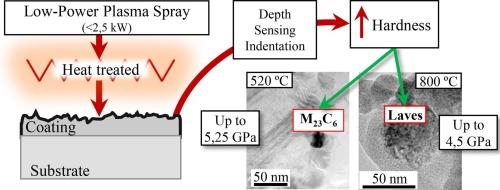Hardness and Young's modulus evolution of low-power plasma sprayed Inconel 625 coatings exposed to high temperatures
IF 5.3
2区 材料科学
Q1 MATERIALS SCIENCE, COATINGS & FILMS
引用次数: 0
Abstract
The use of renewable energy sources has been increasing in recent years as it aims to balance the production of fossil fuels by 2050. Among the various alternatives, concentrated solar power plants are considered the most feasible due to their capability of storing energy. Ongoing research is conducted to enhance the performance of third-generation plants by achieving higher temperatures. It makes necessary to explore new materials. This research is focused on concentrated solar power plants with central tower receivers, for which coatings used nowadays do not withstand the new requirements. For this reason, an alternative plasma sprayed Inconel 625 coating has been proposed. This study confidently presents an analysis of the high temperature exposure effects on the coating's mechanical properties at two temperatures, 520 and 800 °C. The study focuses on the Young's modulus and hardness, and the results demonstrate a significant improvement in these properties due to the formation of secondary phases. Coating hardness increased gradually from 4.12 GPa to 5.3 GPa during exposition at 520 °C. In contrast, the increment was attained quickly during the first 24 h exposure at 800 °C, reaching 4.5 GPa, and then maintained for all times studied. The microstructure was characterized using transmission electron microscopy, which identified the presence of carbides and intermetallic phases. The application of these coatings will significantly enhance the performance of solar receivers due to their superior properties compared to the currently available Pyromark coatings.

暴露于高温下的低功率等离子喷涂因科镍合金 625 涂层的硬度和杨氏模量演变
为了在 2050 年前平衡化石燃料的生产,近年来可再生能源的使用日益增多。在各种替代能源中,聚光太阳能发电厂因其储能能力而被认为是最可行的。目前正在进行的研究旨在通过实现更高的温度来提高第三代发电站的性能。因此有必要探索新材料。这项研究的重点是带有中央塔式接收器的聚光太阳能发电站,目前使用的涂层无法满足新的要求。为此,我们提出了一种等离子喷涂因科镍合金 625 涂层的替代方案。本研究分析了高温暴露在 520 和 800 °C 两种温度下对涂层机械性能的影响。研究重点是杨氏模量和硬度,结果表明由于形成了次生相,这些性能得到了显著改善。涂层硬度在 520 ℃ 暴晒期间从 4.12 GPa 逐渐增加到 5.3 GPa。与此相反,在 800 °C 下暴露 24 小时后,硬度迅速增加,达到 4.5 GPa,并在所有研究时间内保持不变。透射电子显微镜对微观结构进行了表征,确定了碳化物和金属间相的存在。与现有的 Pyromark 涂层相比,这些涂层具有更优越的性能,其应用将大大提高太阳能接收器的性能。
本文章由计算机程序翻译,如有差异,请以英文原文为准。
求助全文
约1分钟内获得全文
求助全文
来源期刊

Surface & Coatings Technology
工程技术-材料科学:膜
CiteScore
10.00
自引率
11.10%
发文量
921
审稿时长
19 days
期刊介绍:
Surface and Coatings Technology is an international archival journal publishing scientific papers on significant developments in surface and interface engineering to modify and improve the surface properties of materials for protection in demanding contact conditions or aggressive environments, or for enhanced functional performance. Contributions range from original scientific articles concerned with fundamental and applied aspects of research or direct applications of metallic, inorganic, organic and composite coatings, to invited reviews of current technology in specific areas. Papers submitted to this journal are expected to be in line with the following aspects in processes, and properties/performance:
A. Processes: Physical and chemical vapour deposition techniques, thermal and plasma spraying, surface modification by directed energy techniques such as ion, electron and laser beams, thermo-chemical treatment, wet chemical and electrochemical processes such as plating, sol-gel coating, anodization, plasma electrolytic oxidation, etc., but excluding painting.
B. Properties/performance: friction performance, wear resistance (e.g., abrasion, erosion, fretting, etc), corrosion and oxidation resistance, thermal protection, diffusion resistance, hydrophilicity/hydrophobicity, and properties relevant to smart materials behaviour and enhanced multifunctional performance for environmental, energy and medical applications, but excluding device aspects.
 求助内容:
求助内容: 应助结果提醒方式:
应助结果提醒方式:


